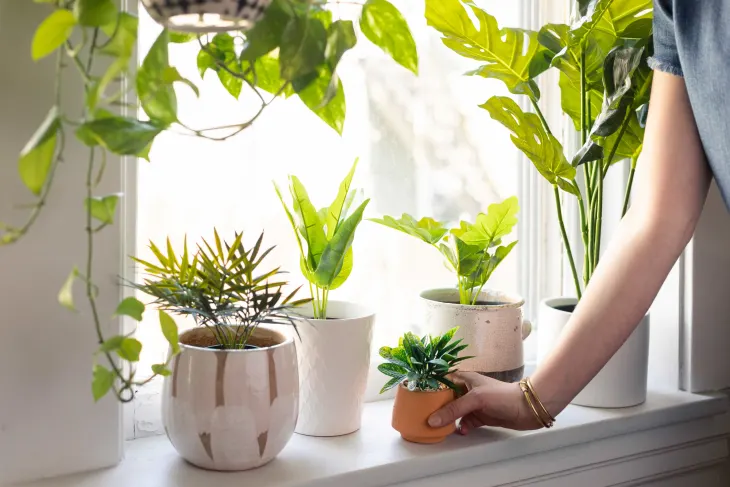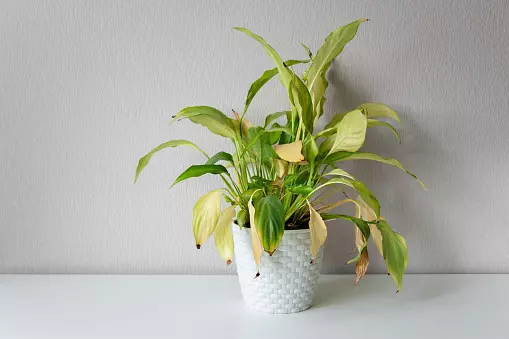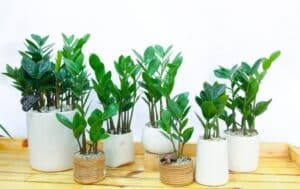Understanding natural light for indoor plants is the foundation of care. Next to water, light is the unparalleled pillar of plant vitality. Many species can survive in poor soil or even without fertilizer, but none can survive without light.
As you delve deeper into the complexities of botany, you will realize that light is not simply a single entity but a spectrum, each shade of which affects the process of photosynthesis, growth patterns and overall plant health. Understanding the importance of natural light ensures that your beloved plants will grow healthy and lush, expressing their full glory and potential.
How much natural light do houseplants need?
Houseplants have a diverse range of light requirements, which are intrinsically tied to their evolutionary origins and biological makeup. At the cellular level, the process of photosynthesis, where light energy is converted into chemical energy, is facilitated by organelles called chloroplasts. The concentration and distribution of chloroplasts in plants are indicative of their light requirements and adaptability.
Plants with a higher concentration of chloroplasts are typically more adept at handling elevated light levels. The high chloroplast concentration allows these plants to effectively capture and utilize more light for photosynthesis. However, it’s important to note that the presence of numerous chloroplasts doesn’t solely determine a plant’s affinity for sunlight. Other factors such as leaf structure, color, and size also play a role in a plant’s light preferences.
One of the fascinating adaptive mechanisms plants exhibit in response to varying light conditions is acclimatization. In circumstances where light is diminished, plants will reposition and often increase the number of chloroplasts to maximize light absorption. This adaptive feature illustrates the dynamic nature of plants and their ability to modify their internal structures based on environmental conditions. It’s this mechanism of acclimatization that permits certain shade-loving plants to be “trained” to endure, and sometimes even thrive in, conditions with higher light intensity than they would naturally prefer.
Nevertheless, while some plants can adjust to differing light conditions through acclimatization, not all plants possess this capability to the same degree. Each species has its inherent range of acceptable light conditions, beyond which sustained health and growth become untenable. Consequently, it is crucial for horticulturists and plant enthusiasts to understand the specific light requirements of each plant species under their care.
The ability of plants to convert sunlight into usable energy underpins the foundation of life on Earth. This conversion process not only sustains the plants themselves but also fuels the broader food chain. When sunlight is absorbed by plants and transformed into energy, it provides the primary energy source for a wide range of organisms. This energy then cascades through the trophic levels, from primary consumers to apex predators. Understanding the light requirements of plants is not merely a matter of horticultural interest but is crucial to comprehending the broader ecological systems that sustain life on our planet.
The difference between direct sunlight and indirect sunlight for plants
Direct and indirect sunlight have distinct attributes, influencing plants differently. Here, LotusBuddhas will delineate the primary differences between direct sunlight and indirect sunlight and their implications for plants:
- Nature of Exposure:
- Direct Sunlight: As you might infer from the name, direct sunlight refers to when the sun’s rays strike the plant without any intervening barrier. In this scenario, there’s an unobstructed path from the sun to the plant.
- Indirect Sunlight: Indirect sunlight occurs when the sun’s rays don’t fall directly on the plant but are rather diffused or reflected by another surface. This can happen when the plant is placed near a source of light, such as a window, but doesn’t receive the full brunt of the sun’s rays.
- Applications for Plants:
- Direct Sunlight: Many sun-loving plants thrive in direct sunlight. They are adapted to handle the intense light and often require it for optimal growth. Examples include many types of cacti, succulents, and flowering plants like roses and sunflowers.
- Indirect Sunlight: Plants that naturally grow under the canopy of larger plants or trees, such as ferns and certain orchids, prefer indirect sunlight. These plants have evolved to flourish without direct sun exposure and can be scorched or stressed if exposed to it.
- Impact on Photosynthesis:
- Direct Sunlight: Promotes a higher rate of photosynthesis due to the increased intensity of light, benefiting plants that have evolved to capitalize on such conditions.
- Indirect Sunlight: Facilitates a slower rate of photosynthesis. However, plants adapted to these conditions are efficient at utilizing lower light levels without getting stressed.
When you select plants for a particular environment or when cultivating them in controlled conditions, discerning between direct and indirect sunlight is imperative. Understanding the distinction will enable you to position plants in a manner conducive to their health and growth, ensuring they receive the appropriate amount and type of sunlight.
The best direction to place houseplants for natural light
Understanding the nuances of natural light as it enters your indoor space is crucial for the optimal growth of houseplants. While it’s common knowledge among seasoned gardeners that indoor light conditions can never truly replicate the intensity of direct outdoor sunlight, you may be less aware of the drastic decrease in light intensity as a plant is positioned further from a window. Therefore, when situating plants indoors, you should not only consider the distance from the window but also the direction the window faces.
In the Northern Hemisphere, the orientation of a window plays a pivotal role in determining the intensity and duration of sunlight received:
- North-facing windows: This orientation generally provides the weakest light intensity. Throughout the day, such windows are usually immersed in deep shade. While you might find success in nurturing shade-loving plants near a north-facing window during the summer, the winter months are less forgiving, often offering insufficient light for most plant species.
- South-facing windows: The sun’s trajectory in the Northern Hemisphere follows a marginally southern east-to-west arc. As a result, windows facing south tend to receive the highest light intensity. Should you place plants in an unobstructed southern window, you can expect them to benefit from the maximum amount of sunlight available indoors.
- East-facing windows: These windows capture the morning sun. This light, while still direct, is not as fierce as the midday or afternoon sun. As such, east-facing windows are typically ideal for plants requiring moderate sunlight or those best suited to morning exposure.
- West-facing windows: Here, plants are exposed to the afternoon and evening sun. While the intensity of light from a west-facing window might not match that of a south-facing one, the sunlight can still be remarkably potent, especially during the summer months. Hence, it would be prudent to place your sun-loving plants in close proximity to such windows.
Positioning your houseplants appropriately based on window orientation is of paramount importance to ensure they receive the necessary light for growth. LotusBuddhas believes that a comprehensive understanding of how sunlight interacts with each window direction will empower you to create optimal conditions for your indoor plants, fostering their health and vitality.
How to measure indoor light intensity
While there are multiple methods to gauge this, a common approach involves observing the shadow cast by the light. If the shadow is sharp and well-defined, it indicates a bright light. Conversely, a fuzzy or indistinct shadow represents moderate light. The absence of a shadow typically indicates a lower light intensity environment.
A more scientific measure often adopted by growers is the foot-candle, which quantifies light intensity based on the luminosity of a single candela. To better comprehend the foot-candle spectrum:
- 200–500 foot-candles: This range represents low light intensity, resembling deep shade. Such an environment is typically unsuitable for most plant varieties.
- 500–1,000 foot-candles: Although still characterized as low light intensity, this range offers sufficient brightness for reading, akin to the ambient light in an average room. It is ideal for shade-loving plants.
- 1,000–2,000 foot-candles: This signifies bright yet indirect sunlight. While it might not cast a pronounced shadow, it caters well to numerous plants that prefer indirect sunlight.
- 2,000–4,000 foot-candles: At this intensity, the light is comparable to about 40 percent of the midday sun. Direct sunlight entering through windows falls within this range, making it ideal for plants necessitating robust light intensity.
- 4,000–5,000 foot-candles: Representing approximately 50 percent of the midday sun, this range corresponds to strong direct sunlight in a luminous room, best suited for plants with elevated light demands.
- 5,000 and above foot-candles: This is indicative of exceedingly bright indoor light.
To offer some context, it’s beneficial to recognize that full outdoor sunlight amounts to around 10,000–12,000 foot-candles. Consequently, even the most illuminated indoor spaces seldom reach this level.
However, caution is advised when positioning plants close to windows. The glass can amplify the sunlight, functioning like a magnifying lens, which, combined with a plant’s potential lack of acclimation to direct sunlight, can lead to damage. Therefore, even in the presence of sophisticated measuring techniques, you should observe your plants for tangible indicators of their well-being. Yellowing leaves or burned spots might suggest excessive sunlight, while elongated growth could imply insufficient light. Ultimately, the plant itself provides invaluable insights regarding the appropriateness of its lighting environment.
The signs of insufficient light with houseplants
When you are caring for houseplants, you have to be attuned to the visual cues they exhibit, as these can be indicative of their overall health. Light is a paramount factor in plant growth, and insufficient light can detrimentally affect their vitality.
- Etiolation (Stretched Growth): The most evident sign of inadequate light is etiolation. You’ll observe that the stems of the plant elongate disproportionately, making the plant appear leggy. This elongation is a plant’s natural response to reach out for more light.
- Smaller Leaves: You may notice that the newer leaves are smaller than the older ones. This is because the plant isn’t receiving enough energy from light to produce leaves at its typical size.
- Fewer Flowers or No Flowering: Insufficient light can also result in reduced flowering or a complete absence of blooms. If you find that your flowering houseplants aren’t producing as many flowers as expected, or if flowering plants aren’t blooming at all, light levels could be a factor.
- Yellowing Leaves: While many factors can lead to yellow leaves, inadequate light can cause the lower leaves to turn yellow and drop prematurely. This is different from the natural aging process of leaves.
- Leaves Grow Toward the Light: You may find that your plant is leaning or growing predominantly in one direction, towards the nearest light source. This is an evident sign of the plant trying to maximize its exposure to light.
- Sparse Growth: Another symptom you might encounter is that the plant appears sparser, with more significant gaps between leaves or nodes on the stem, indicating that it’s not growing as densely as it would under optimal lighting conditions.
- Loss of Leaf Variegation: For plants that have variegated leaves, insufficient light can lead to a loss of variegation, causing the leaves to turn entirely green. This happens as the plant tries to produce more chlorophyll to maximize photosynthesis.
- Weak or Fragile Growth: Insufficient light can also result in plants exhibiting weak, fragile growth. You’ll notice that the stems are thinner, and the overall plant structure seems delicate.
To address these signs, you should adjust light exposure by repositioning the plant or increasing natural light with artificial sources. Regularly checking on your plants and understanding their specific light requirements will help you provide optimal conditions.
Which houseplants thrive in low light conditions?
Some plants, having evolved in understories or shaded environments, are particularly adapted to low light conditions. Such plants are ideal candidates for indoor settings with limited sunlight. Below is a list of houseplants that thrive in low light conditions:
- Sansevieria (Snake Plant): A hardy plant, snake plant can tolerate a range of light conditions, including low light. Its tall, upright leaves with striking patterns make it a favorite among indoor gardeners.
- Zamioculcas zamiifolia (ZZ Plant): This plant is lauded for its resilience. Its glossy, dark green leaves can flourish even with minimal light exposure.
- Aglaonema (Chinese Evergreen): Chinese evergreen species are renowned for their vibrant and variegated leaves. These plants are not only aesthetically appealing but are also adept at thriving in low light conditions.
- Spathiphyllum (Peace Lily): Not only does the Peace Lily thrive in low light, but it also produces elegant white blooms, enhancing its ornamental appeal.
- Aspidistra elatior (Cast Iron Plant): True to its name, the Cast Iron Plant is robust and can withstand not just low light but also neglect.
- Philodendron: Many Philodendron species, especially the vining types, adapt well to lower light levels, making them suitable for dimmer indoor spaces.
- Maranta leuconeura (Prayer Plant): Recognized for its ornate leaf patterns, prayer plant is another excellent choice for spaces with limited light.
- Dracaena: Several Dracaena species, including Dracaena marginata and Dracaena fragrans, can flourish in low light conditions. Their long, slender leaves add a touch of elegance to indoor settings.
- Ficus elastica (Rubber Plant): While it prefers brighter indirect light, the Rubber Plant can adapt to lower light levels if necessary.
- Chlorophytum comosum (Spider Plant): Spider plant, characterized by its arching green and white striped leaves, can manage well in less illuminated spaces.
When cultivating these plants in low light conditions,you have to monitor them for signs of stress or poor health. While they are adapted to thrive with minimal light, occasional rotations or shifts to ensure all parts of the plant receive light can be beneficial. Additionally, you also should understanding the specific water and nutrient needs of each species will further enhance their growth and longevity in indoor settings.










